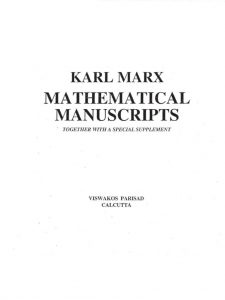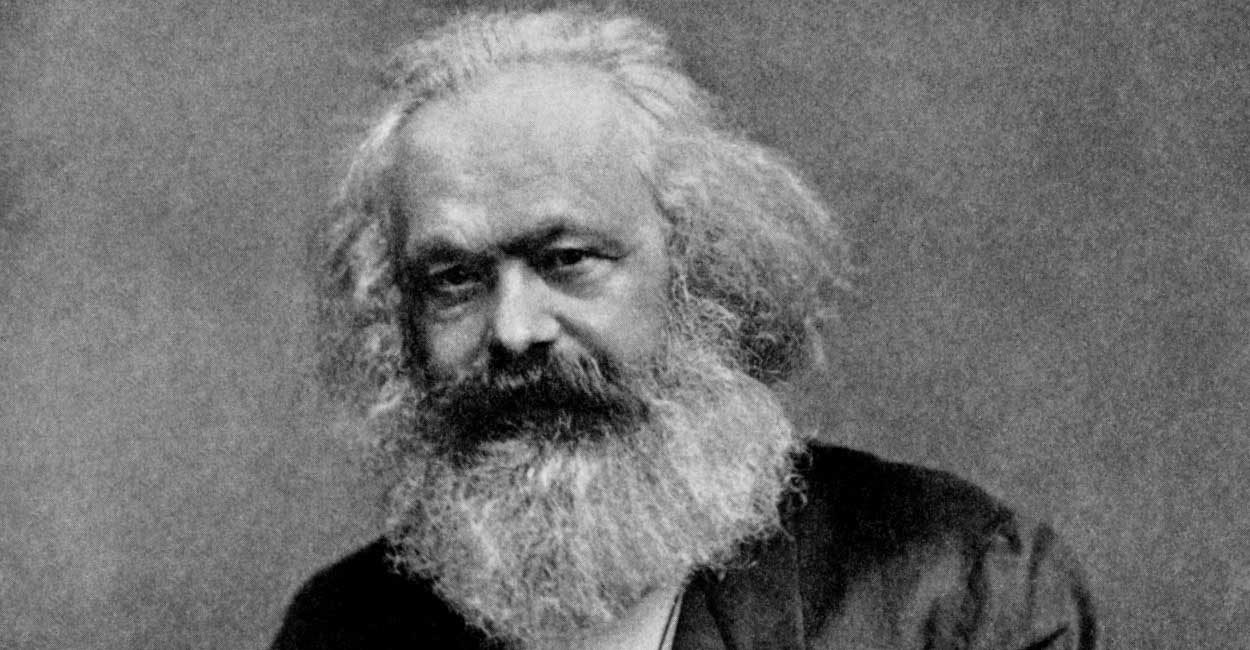Reading Time: 6 minutes
Perhaps very few Marxists and admirers of Marx know that Marx’s contributions were not at all limited to economics and politics. Mathematics apart, his notes, manuscripts, and correspondences cover chemistry, geology, ethnology and even linguistics inter alia. Those studies are of great relevance to the so-called ‘peripheral economies’ like India and its neighbouring countries. A report, for Different Truths.
Twenty-five years ago, as grapevine had it, when the then general secretary of Communist Party of India Indrajit Gupta was reportedly approached to write a forward for the first comprehensive English version of Karl Marx’s Mathematical Manuscripts from the Russian text, the CPI leader declined confessing that he couldn’t write anything about a work which he wasn’t aware of, let alone having read it. However, the translator, Pradip Baksi, a Kolkata-based- Marx scholar and a rare strain of polymath, is not aware of this. But the maverick CPI(M) leader Subhas Chakraborty ensured that the then CPI(M) general secretary Harkishan Singh Surjeet would write the forward Baksi confirms. CPI and CPI(M) leaders were expected to be abreast of the fact the Moscow-publisher ‘Nauka’ had published it in 1968 in Russian. And it’s not that no Indian communist leader or ‘ideologue’, including Gupta and Surjeet, had read the voluminous text which was already discussed among historians of mathematics abroad. Marx prepared the manuscript at the fag end of his life.
Entitled, “Karl Marx’s Mathematical Manuscripts with A Special Supplement”, the translator wrote in the preface to his 569-page book, based on an extensive research in original texts, “In K Marx’s Matematicheskie Rukopisi (“Nauka” M.,1968), Marx’s own texts have been published both in the original  language (mainly German, but in places French, English or a mixture of two or more of these languages) and in Russian translation. However, the preface, editorial comments, notes, and appendices are all in Russian only. Hence, Russian is the only single language through which the entirety of this volume becomes accessible. The present translation has throughout followed title texts, comments, notes and appendices in Russian. However, where Marx’s own text is only in English, then that has been reproduced. I have added two notes: 98a & 11I a, and a few comments and footnotes. The preface of the 1968 edition has been variously superseded by the developments in Marx studies and in mathematics. A new preface is due. I began writing one, but it got out of hand. The result: a special supplement, entitled Marx and Mathematics. The sources of the materials’ included in this supplement have all been indicated at the end of each item”.
language (mainly German, but in places French, English or a mixture of two or more of these languages) and in Russian translation. However, the preface, editorial comments, notes, and appendices are all in Russian only. Hence, Russian is the only single language through which the entirety of this volume becomes accessible. The present translation has throughout followed title texts, comments, notes and appendices in Russian. However, where Marx’s own text is only in English, then that has been reproduced. I have added two notes: 98a & 11I a, and a few comments and footnotes. The preface of the 1968 edition has been variously superseded by the developments in Marx studies and in mathematics. A new preface is due. I began writing one, but it got out of hand. The result: a special supplement, entitled Marx and Mathematics. The sources of the materials’ included in this supplement have all been indicated at the end of each item”.
From the preface to the Russian edition (1968), we learn that the Moore was self-educated in mathematics but was helped by his friend Samuel Moore as he had “very little mathematical knowledge” Marx took up studying differential calculus, thanks to the relevant textbooks which were then in use in the Cambridge University. He kept sending manuscripts with remarks on the sidelines to his great friend and theoretical collaborator Friedrich Engels in 1881. “This book was written according to the method of Leibnilz, and Leibnitzian symbols… Soon after this, the very Newtonian method of ‘analysis through equations containing an infinite number of terms’, drew Marx’s attention. Marx became so enthused after having considered the Leibnitzian algorithms of differential calculus … that he undertook the task of explaining them (using the example of the tangent to the parabola), in the special appendix of a letter to Engels”, the preface states. It is well-known that the modern development of calculus is credited to the 17th-century geniuses in the fields of mathematics and physics, Isaac Newton, and Gottfried Leibnitz.
Perhaps very few Marxists and admirers of Marx know that Marx’s contributions were not at all limited to economics and politics. Mathematics apart, his notes, manuscripts, and correspondences cover chemistry, geology, ethnology and even linguistics inter alia. Those studies are of great relevance to the so-called ‘peripheral economies’ like India and its neighbouring countries. In an interview with this writer, published in a website kafila-online on 12 May 2015, Baksi stated crisply, “Marx’s notes and excerpts on geology, chemistry, ethnology, agronomy, and comparative history of land relations, indicate the directions of his investigations in respect of the landed property. The domain of wage-labour, briefly described in the Capital, Volume I, Chapters XIX-XXII, needs to be tackled in conjunction with investigations on its source and precondition, namely, of wageless-labour, including that of the women and children in the patriarchal families.
Marx left a very brief draft plan for a work on the modern state (Marx/Engels, Collected Works, Vol 4, p 666). His voluminous notes and excerpts on the legal and juridical history of many countries, including those concerning the Dharmashastras and Shariati codes of India, are of direct relevance here. The directions of his study of foreign trade and world market are indicated in many places within his scientific and journalistic writings”.
666). His voluminous notes and excerpts on the legal and juridical history of many countries, including those concerning the Dharmashastras and Shariati codes of India, are of direct relevance here. The directions of his study of foreign trade and world market are indicated in many places within his scientific and journalistic writings”.
Consider Marx’s Ethnological Notebooks, first transcribed into English in the early 1970s by Lawrence Krader. It was a new enlightenment to scholars and students. The 250-page notes, compiled by Marx on Lewis Henry Morgan and other anthropologists in his twilight years, “showed us as never before a Marx concerned as much with gender relations and with non-Western societies such as India, pre-Colombian Mexico, and the Australian aborigines, as well as ancient Ireland, as he was with the emancipation of the industrial proletariat”, aptly stated by Kevin Anderson, a well-known Marx scholar.
Marx in a letter to Engels of January 28, 1863 referred to his notebooks (not known before the present MEGA), “I have re-read my notebooks (extracts) on technology and am attending a practical (only experimental) course for workers on the same by Professor Willis (in Jermyn Street, the Institute for Geology, where Huxley also gave his lectures). While re-reading the technological-historical excerpts, I came to the conclusion that, apart from the invention of gunpowder, the compass and printing – these necessary pre-requisites for bourgeois development – from the 16th to the mid-18th centuries, i.e. the period of the development of manufacture from craftsmanship until really large-scale industry, the two material foundations on which were based the preparations for mechanised industry within manufacturing were the clock and the mill”. This is another evidence of Marx’s interests in science and technology. John Bellamy Foster, editor of Monthly Review, in “The Ecological Rift: Capitalism’s War on the Earth”, co-authored by Richard York and Brett Clark, acknowledges Baksi’s paper, “Karl Marx’s Study of Science and Technology” (1996).
All this happened due to the on-going international project Marx-Engels-Gesamtausgabe or complete works of Karl Marx and Friedrich Engels (MEGA) which collates original texts, notes, manuscripts and correspondences among Marx, Engels and their contemporaries. Insulation from partyocracy too was a major advantage. MEGA was first conceived as a project at the Marx–Engels Institute [later, rechristened as the Institute of Marxism-Leninism (IML) in the early 1920s mainly under the initiative of Lenin who assigned the project to David Borisovich Ryazanov (real name David Borisovich Gol’dendakh), arguably the greatest Marx scholar of the 20th Century.
Sadly enough, Joseph Stalin and his cronies went after his blood and Ryazanov was among the first victims during the high-voltage era of Stalinism and the cruelties thereof. The on-going venture, a historical-critical project, at the International Marx Engels Foundation (IMES) in Amsterdam as the biggest archive of original manuscripts is at the International Institute of Social History (IISH) – an institute under the Royal Netherlands Academy of Arts and Sciences (KNAW). IISH apart, the Karl Marx-House of the Friedrich Ebert Foundation in Trier, Berlin-Brandenburg Academy of Sciences and Humanities (BBAW), the Social Research Institute of the Friedrich Ebert Foundation in Bonn and the Russian State Archive for Socio-Political History (RGASPI), together with the previous publishing institutions. Baksi informs that a part of Mathematical manuscripts was brought out for the first time in 1933, after removal of Ryazanov from the IML in 1931. Needless to say, the entire text was prepared and made ready for printing by the great Marx scholar whom the Comintern journal, Inprecor, termed as the ‘greatest Marxologist of his time.
Marx’s magnum opus Capital’s demand is now bullish. The posterity will tell whether Marx who is unquestionably the economist of the 21st century will rekindle new aspirations for building a just and libertarian society a republic of labour, cooperative society, union of free individuals, the society of free and associated producers – all synonyms for communist or socialist society, as envisioned by Marx.
Sankar Ray
©IPA Service
Photo from the Internet
#Marx #Engel #CommunistPartyOfIndia #Tribute #DifferentTruths

















